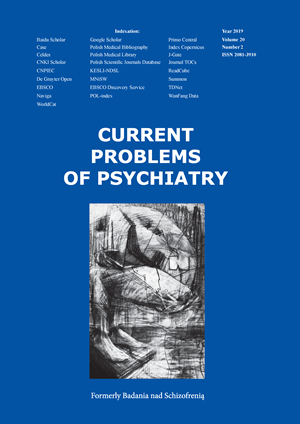Therapy of a schizoaffective disorder as a risk factor of perinatal complications and fetal developmental disorders
DOI:
https://doi.org/10.2478/cpp-2019-0010Keywords:
schizoaffective disorder, congenital malformations, nicotinism, gestational diabetesAbstract
Introduction: Schizoaffective disorder is described as a combination of symptoms of schizophrenia and mood disorder components. It is estimated that in 2009 in Poland over 30 thousands women were treated in outpatient care because of schizotypical disorders, also in 2009, over 5,5 thousands Polish women, were hospitalised because of the same reason.
Material and method: We searched through whole medical documentation of the patient, which were available at the Department of Psychiatry and Gynaecology. We mainly focused on the last hospitalization of the woman. We found research connected to our subject on Science Direct website.
Discussion: A 34-year-old woman was admitted to Department of Psychiatry, patient was 14 weeks pregnant. Family described her behaviour as verbally and physically aggressive and dysphoric which forced her parents to take woman to the hospital. It was her third hospitalization. Pharmacotherapy was insufficient to improve the mental state of the woman. Doctors decided to carry out a series of electroconvulsive treatments (10 procedures). When woman was 36 weeks pregnant, there was a leak of green amniotic fluid and it was necessary to perform a caesarean section. A newborn required mechanical ventilation, had decreased muscle tone and facial dysmorphic features, also defect of the atrial septum was found.
Conclusions: Pregnant women with psychiatric disorders should be all considered high risk. It means that they need multidisciplinary care – psychiatrist, gynaecologist, neonatologist or other specialists, in order to stay in a good condition mentally and physically during pregnancy.
References
1. Jarema M, Rabe-Jabłońska J: Psychiatria 2016; wyd. 2: 125-137.
2. Mayoclinic.org. Mayo Clinic Staff.: Schizoaffective Disorder 2017; [cytowana 6 czerwca 2019]. Dostępna z: https://www.mayoclinic.org/diseases-conditions/schizoaffective-disorder/symptoms-causes/syc-20354504
3. Główny Urząd Statystyczny: Zdrowie kobiet w Polsce w latach 2004-2009.
4. www.fda.gov. Food and Drug Administration: Classification of drugs during pregnancy; [cytowana 6 czerwca 2019]
5. Indeks Leków Medycyny Praktycznej: 2019.
6. Bulbul F, Copoglu US, Alpak G, Unal A, Demir B, Tastan MF, Savas HA: Electroconvulsive therapy in pregnant patients. Gen Hosp Psychiatry. 2013;35:636-9.
7. Mayoclinic.org. Mayo Clinic Staff.: Electroconvulsive therapy (ECT) 2018; [cytowana 6 czerwca 2019]
8. Łagoda K, Kobus G, Bachórzewska-Gajewska H: Wpływ cukrzycy ciążowej na rozwój płodu i noworodka. Endokrynol. Otył. Zab. Przem. Mat. 2008; 4:168-173.
9. Polańska K, Hanke W. Palenie papierosów przez kobiety ciężarne a przebieg i wynik ciąży – przegląd badań epidemiologicznych. Przegl Epidemiol. 2004; 58: 683-691.
10. Milnerowicz H, Zalewski J, Geneja R, Milnerowicz-Nabzdyk E, Woyton J, Levels of Cd, Pb in blood and Zn, Cu, Cd, Pb in amniotic fluid of tobaccosmoking women during pregnancy complicated oligohydramnios orpremature rupture of membranes, Ginekol. Pol. 2000;311-316.
11. Milnerowicz-Nabzdyk E, Bizon A, Effect of cigarette smoking on vascularflows in pregnanciescomplicated by intrauterine growth restriction, Reprod.Toxicol. 2014;27-35.
Downloads
Published
Issue
Section
License
Copyright (c) 2019 Authors

This work is licensed under a Creative Commons Attribution-NonCommercial-NoDerivatives 3.0 Unported License.


